Cannabis must flower and produce seeds to successfully complete its annual life cycle. It is a dioecious plant, being either male (pollen producing) or female (ovule producing). However, intersex plants—mistakenly called hermaphrodite plants, with both male and female flowers—can also occur. Feminized seed that produces only female plants is also available.
In nature, cannabis flowers in the fall,* after the long, hot days of summer. The long nights and short days of autumn help signal cannabis to start flowering. (Plants are either “short-day” or “long-day.” “Long-day” plants, including most varieties of cannabis, require short days and long nights to flower. For more information on this subject, see “Florigen”.)
Plants are normally either male or female. Feminized seed that grows only female plants is also very popular. Cannabis produces male or female pre-flowers after 4 weeks of vegetative growth. For more information, see “Pre-flowering” in this chapter.
*Cannabis ruderalis–dominant varieties flower after 3 to four weeks of growth, regardless of light/dark regimen. Plants with the “ruderalis” gene are called “autoflowering” varieties.
Growth patterns and chemistry change during flowering. Cannabinoid production slows at first and then accelerates; flower formation is rapid at first and then slows. Stems elongate; leaves grow progressively fewer blades. This tendency is more pronounced in indica varieties than in sativas. Nutrient needs change as growth stages change. Plants focus on flower production rather than vegetative growth. Green chlorophyll production, which requires much nitrogen, slows. Calcium, phosphorus, and potassium uptake increases to promote floral formation.

These plants are growing in Morocco. You can see the Rif Mountains in the background.
When flowering is initiated, organic cannabis gardeners change to a soluble flowering mix with less nitrogen. Gardeners that use chemical salt–based nutrients switch to a “super bloom” formula with less nitrogen and more calcium, potassium, and phosphorus. The fertilizer is added when flowering is induced indoors. Both fertilizer regimens promote bigger flower buds.
Changing the ratio of nutrients during flowering does not mean that plants need no nitrogen. For example, there is a lag time in growing mediums’ ability to hold fertility while other substrates hold nutrients for a very short time. This is why the fertilizer ratio should be changed after floral induction. The increase in floral nutrients necessary during flowering, most notably phosphorus (P) and potassium (K), is gradual rather than immediate. The medium holds some elements but the cation sites readjust to equilibrium as necessary. The plant is vegetating when the light is changed to 12 hours. It will take 3 to 5 more days for preprogrammed leaf growth on the meristem to manifest. After several 12-hour nights, the cells in the meristem are reprogrammed to flower. At this point cells start looking for a different nutrient menu.
Cannabis is in vegetative growth during the transition to flowering and has vegetative nutrient needs. The same nutrients are required during growth and flowering, only the ratio between them changes. For the first few days this ratio may change from minute to minute, so we provide different ratios of nutrients during this time and plants are able to extract what they need. Careful monitoring of feeding will help plants always have a complete menu of nutrients.

Phyllotaxy, the arrangement of leaves on the stem, changes when a plant enters the flowering stage. Branches are symmetrical lower on the plant, and will change to asymmetrical as flowering progresses.

Here is a close-up of asymmetrical growth— one of the first signs of flowering. (MF)
Trichomes and Resin Glands
During flowering, cannabinoid-rich resin glands and other trichomes on foliage become clearly visible with the naked eye. The capitate-stalked glands that cover bracts and small bud-leaves interspersing the buds are the most important to medical cannabis gardeners. These glands account for more than half of all the THC contained in the plant.
Bulbous and sessile resin glands on the surfaces of all flowers, leaves, stalks, and branches, along with a small amount of THC present in interior cells, account for the balance of total THC. These large, stalked glands are our focus.
Florigen
Florigen (also known as “the flowering hormone”) is the term used to describe the molecules that initiate and maintain flowering. Since the 1930s, biologists have believed that florigen is responsible for controlling flowering in plants, but it was not until August 2011 that a group of Japanese scientists discovered specific florigen hormone receptors. Florigen is synthesized in leaves and stimulated by environmental changes such as photoperiod and temperature.
Florigen is found at the apex of shoots where buds grow to induce flowering. It redirects vegetative stem apexes to become flowering stem apexes. The subject is quite complex and beyond the scope of this book.

Florigen is the elusive hormone thought to be responsible for flowering.

This crop was induced to flower with a 12/12- hour day/night photoperiod. The onset of flowering causes growth patterns, as well as chemistry, to change.

Pests and diseases would have a difficult time attacking this ‘Chocolope’ bud covered with resin glands.

Pointy sessile resin glands (cystolith hairs) contain no cannabinoids, but the capitate‑stalked resin glands with a ball on top are packed with cannabinoids. (MF)
Trichomes
Biologists hypothesize that trichomes evolved as a defense mechanism of the cannabis plant against a range of potential enemies. These adhesive sprouts form a protective layer against offensive insects and mites, preventing them from reaching the surface of the plant. The chemicals in the trichomes make cannabis less palatable to animals and can inhibit the growth of some types of fungus.
The protective trichomes also help insulate plants from desiccating wind and low humidity as well as forming a natural “sunscreen” to protect against UVB light rays.
Humans may have promoted heavier resin production through casual selective breeding.
“All mice are animals, but not all animals are mice. Similarly, all resin glands are trichomes, but not all trichomes are resin glands. Trichome is a general botanical term for any outgrowth of an epidermal cell. Trichomes can be scales, root hairs, glandular or nonglandular, single or multicellular, often hairlike growths. Cannabis has three kinds of resin glands (bulbous, capitate-sessile, and capitate-stalked) and several of non-resinous silica and carbonate warts and hairs, all called trichomes.”
Mel Frank, Cannabis author, researcher, and photographer
Nonglandular Trichomes
Nonglandular trichomes—cystolithic (sessile and cystolith glands [also known as plant hairs]) are common on many plants and do not produce cannabinoids. These trichomes have a pointed tip and are often long and hairlike. The waxy protective trichomes are most common on leaf undersides, petioles, and stems.
More common on some varieties than others, cystolithic trichomes are most abundant on outdoor plants. More cystolithic trichomes form on plants when they harden-off and are moved from indoors to outdoors. The glands exude insecticidal and miticidal substances to gum up pests’ mouthparts and repel them, but they have no useful cannabinoids.
Bulbous Glands
Bulbous glands are the smallest glands, ranging in size from 15 to 30 micrometers. One to 4 cells constitute the “foot” and “stalk,” and 1 to 4 cells make up the “head” of the gland. Head cells secrete a resin, believed to be cannabinoid-rich, along with related compounds that accumulate between the head cells and the cuticle. A nipple-like bulge may form on the membrane from the pressure of built-up resin as these glands mature. Look for bulbous glands scattered about on foliage surfaces.

Cystolith hairs point in the direction of growing shoots. (MF)

These cystolith hairs have mutated and lost their way. (MF)

Bulbous glands sit on a base of a few cells located on foliage and flower buds. (MF)
Capitate-Sessile Resin Glands
Capitate-sessile glands measure from 25 to 100 micrometers across the globular-shaped head or bulb. The bulb appears to lie flush on young and immature plants. One to 4 cells below the bulb is the beginning of a stalk that elongates and grows during flowering to transform the capitate-sessile gland into a capitate-stalked resin gland.
The globular head or ball is composed of 8 to 16 cells that form a dome. The specialized cells secrete a cannabinoid-rich resin that collects between the rosette, and its outer membrane appears spherical.

Capitate-sessile (bulbous glands) are visible near the center of the leaf. Capitate-stalked resin glands grow progressively taller and are clearly visible on the edges of this leaf of ‘Blueberry × Sandstorm’.

Long, thin stalks support the ball-like heads of capitate-stalked resin glands.

Capitate-stalked resin glands are full of chemical activity. This is where the majority of cannabinoids occur. Disc cells, and principally the secretory cavity, of the gland perform a key role in the physiology of secondary products. But these activities are not yet completely understood.
Capitate-Stalked Resin Glands
Capitate-stalked trichomes appear and become visible with the naked eye when flowers form. Use a 10X to 30X handheld lens to distinguish resin glands—bulbous, capitate-sessile, capitate-stalked, and nonglandular trichomes. Look for them on female flower bracts and new flower growth and surrounding foliage where they form heavily on the plant. The resin glands also tend to accumulate heavily on veins of lower leaf surfaces around flower buds. Cannabinoid-potent varieties typically contain higher concentrations of capitate-stalked resin glands.

Look closely and you can see the pointy cystolithic, nonglandular trichomes alongside the more numerous capitate-stalked glandular trichomes.

This electron scanning microscopic view at 370X of a single capitate-stalked resin gland allows us to distinguish individual cells. These 150- to 500-micrometer-tall resin glands are pretty tough when they are young and strong. But once they age they become more fragile.
Male plants and flowers contain smaller and lower concentrations of less-potent stalked glands than found on the female bracts. Male flowers typically have a row of large capitate-sessile glands along opposite sides of anthers.
Unless clearly visible on leaf surfaces, few cannabinoids are found on older leaves. Leaves around flower buds are much more densely populated with capitate-stalked resin glands rich in cannabinoids.
Capitate-stalked resin glands are composed of a stalk with a bulbous head. They look like a post with a knob, ball, or bulb at the top. They form mainly on flower buds and small leaves. The highest concentration of cannabinoids is located at the base of the bulbous resin head.
In the above illustration, disc cells are shown attached to foliage by stipe cells (red) and basal cells (green). The plastid (orange) in disc cells secrete lipoplasts where they synthesize lipophilic substances that accumulate and ultimately migrate and form BLUE vesicles. THC occurs in the top of the capitate-stalked resin gland.

Una “serpiente” de hachís ha sido añadida a este cigarrillo liado de cannabis.
Cannabinoid Profile
Many cannabinoids (CBD), not just THC, have unique effects on brain functions, which in turn cause different effects on human cognition and psychiatric symptoms. Different levels of cannabinoids relative to one another produce different effects. As a result, measuring the “potency” of cannabis plants is problematic.
A very resinous plant could have low levels of THC and high levels of CBD. Or a plant with little resin could contain high levels of THC and low levels of CBD. Cannabinoid profile depends on the makeup of cannabinoids and other active ingredients. For example, resin consists of cannabinoids and other substances such as non-psychoactive resins like phenolic and terpenoid polymers, glycerides, and triterpenes. When resin is concentrated in kief or hashish, about a third is water-soluble plant material, another third is non-psychoactive resins, and the balance cannabinoids.
In many cannabis plants, THC may be only a very small percentage of the total cannabinoids. The remainder (5 to 10 percent) of the resin will be essential oils, sterols, fatty acids, and various hydrocarbons common to plants.
About 80 to 90 percent of the cannabinoids are synthesized and stored in microscopic resin glands that appear on the outer surfaces of all plant parts except the root and seed.
The arrangement and number (concentration) of resin glands vary somewhat with the particular strain examined. Marijuana varieties generally have more resin glands, and they are larger than resin glands on non-drug varieties.
Resins occasionally secrete through pores in the membrane of gland heads. Usually secretion occurs many weeks after stalked glands appear. The glands seem to empty their contents, leaving hollow spaces (vacuoles) in the stalk and head cells. After secretion, the glands cease to function and begin to degenerate. Gland heads, stalks, and trichomes become clumped together, and the whole flowering surface becomes a sticky mass. This is not necessarily desirable.
Small quantities of cannabinoids are present in the internal tissues of the plant. The bulk is found in small single cells (non-articulated laticifers) that elongate to form small, individual resin canals. The resin canals ramify the developing shoots, and penetrate the plant’s conducting tissue (phloem). Minute clumps of resin found in the phloem are probably deposited by these resin canals. Other plant cells contain insignificant amounts of cannabinoids and probably a good 90 percent of the cannabinoids are localized in the resin glands.
Cannabinoid Production
More than 36 tons (79,366 pounds) per hectare (2.5 acres) of dry medical cannabis flower buds can be grown in successive or continual crops in a well-equipped greenhouse under controlled conditions. This works out to 9.92 pounds per 11.1 square feet (3.6 kg/m2) of greenhouse growing space per year.
The breakdown of the harvest consists of 9 tons of cannabinoids (about 66%) and essential oils (about 33 %) per hectare, 1.98 pounds per 11.1 square feet (900 gm/m2) per year.
* “Guidelines for Good Agricultural and Wild Collection Practices for Medicinal and Aromatic Plants”
Terpenes and Essential Oils
Lightweight terpenes belong to a large group of unsaturated hydrocarbons, several of which can be extracted with steam distillation. The product, essential oil, holds aroma, flavor, and specific character.
Five essential oils, including the mono- and sesquiterpenes, alpha- and beta-pinene, limonene, mycene, and beta-phallandrene impart virtually all of the sweet, unique, minty, citrusy, etc., qualities found in odorless cannabinoids. The volatile oils enter the atmosphere and dissipate over time. This causes cannabis to lose much of its bouquet and flavor when stored.
Essential oils constitute 0.1 to 0.3 percent of the dry weight of a fresh marijuana sample—about 10 percent of the weight of the cannabinoids. For every 1000 grams of dry bud, from 1 to 3 grams of essential oil is extracted. Essential oils are predominately found inside heads resin glands, and they have been detected in the resin canals or laticifers.
The mix of essential oils is diverse in different samples of cannabis. Some scientists hypothesize that cannabis content and fragrance may be associated because essential oils are precursors or are related to the cannabinoids.

Jack Herer‘ from Sensi Seeds consistently produces high levels of cannabinoids.

Small buds are developing on this ‘Chocolope’ clone 2 weeks after inducing flowering with a 12-hour photoperiod.
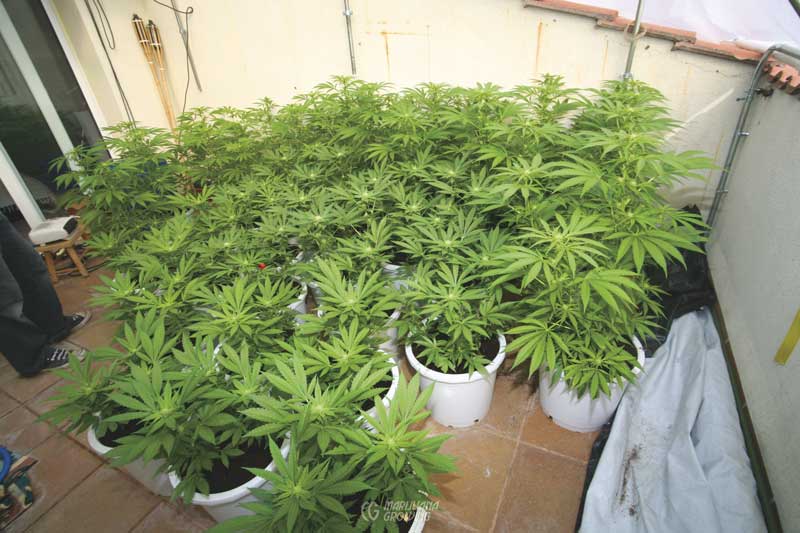
These little clones have just started to flower.

This garden is flowering under 12 hours of darkness and 12 hours of light every 24 hours.
Indica, Sativa, and Ruderalis
Induce sativa and indica varieties and crosses to flower in greenhouses and indoors by giving plants more hours of total darkness and fewer hours of light.
Outdoors, cannabis will flower when it receives 12 hours or more of darkness daily. Give cannabis 12 hours of uninterrupted darkness and 12 hours of light to induce visible signs of flowering in about two weeks. This program is effective in all but the latest blooming pure sativa varieties.
Medicinal cannabis gardeners with a vegetative room illuminated 18 to 24 hours a day and a flowering room or greenhouse with 12-hour days and 12- hour nights, create environments that mimic the photoperiod in spring and fall. With this simple combination a crop can be harvested every 6 to 10 weeks. In warm southern climates or with the help of artificial light, the harvest can last all year.
Plants show sex (male or female flowers,) during the pre-flowering stage, which actually occurs during vegetative growth (discussed on page 92). Once the sex of the plant is established, males, unless used for breeding, are harvested before they shed pollen, and females are coaxed into higher yields. Once the photoperiod is set, disrupting it can cause plants to suffer stress. If they suffer enough stress, intersex (hermaphrodite) tendencies increase. Water intake of flowering plants is usually somewhat less than in the vegetative stage. Adequate water during flowering is important for plants to carry on internal chemistry and cannabinoid production. Withholding water to “stress” a plant will actually stunt growth and diminish yield.

‘Original Afghani #1’ from 1978 had reddish stigmas, but more often this variety would have had white stigmas. (MF)

This pure sativa from Mexico shows classic long thin leaf blades. (MF)

The tall ‘Durban Poison’ phenotype has large narrow-blade sativa leaves.
Pure Cannabis sativa has its origins in tropical regions. Tropical varieties are accustomed to 12 hours of sunlight and equal darkness all year round. The climate is such that they have a long and temperate growing season with leisurely and consistent growth. Super intense sunlight can be difficult for them to assimilate. Many tropical sativa varieties grow under the shade of the jungle canopy. Indoors, gardeners often give pure tropical sativas too much light. The result is even smaller and lighter flower buds. Lamps are set further away or use lower wattage bulbs that produce less intensity and heat. Plants do not get as hot and receive adequate light to grow big flower buds.
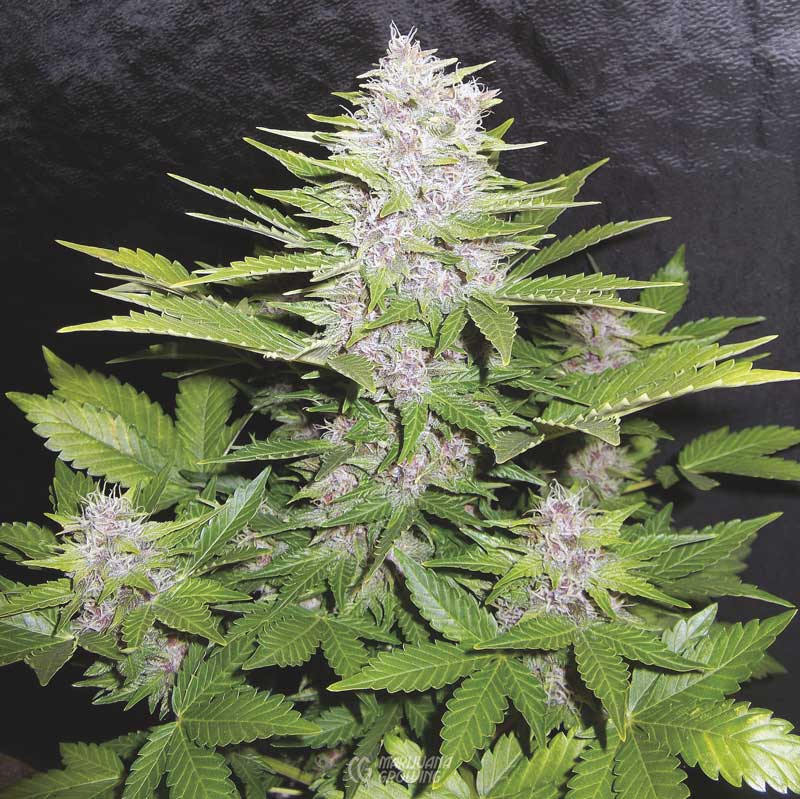
This autoflowering feminized plant was bred to be grown in a sea of green (SOG) garden.
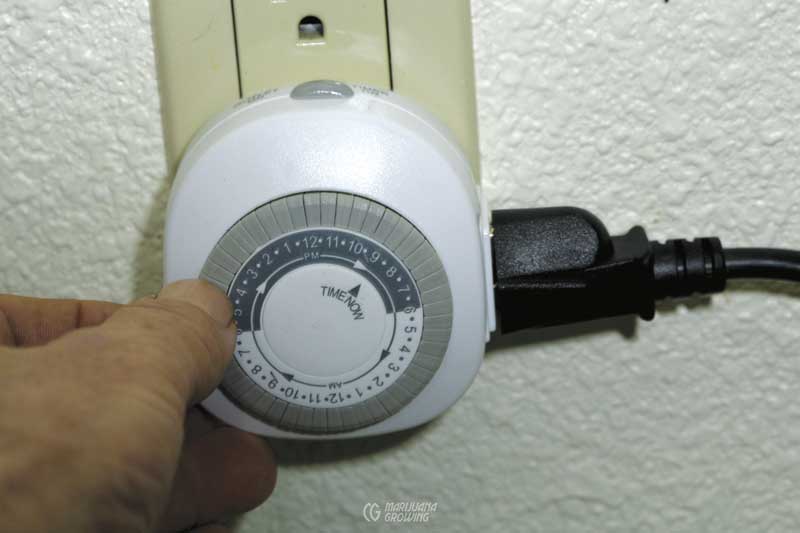
If the photoperiod bounces around, it causes plants to suffer stress. Make sure the timer works properly, and inspect it periodically.

A tiny male flower can be seen on this female flower cluster. The male flower appeared late, when the female was overripe.
Give pure tropical sativas more darkness and less light to induce flowering—11 or 12 hours of light and 13 or 12 hours of darkness. Some gardeners go so far as to gradually decrease daylight hours to 10 daily with 14 hours or more of darkness. Such practices simulate native climates, which gives plants a chance to express their genetics. This technique will promote bigger flower buds.
Autoflowering Cannabis ruderalis varieties do not require long nights to flower. C. ruderalis starts to flower within a month of germinating. Many autoflowering ruderalis varieties are ready to harvest 70 days after planting and produce up to 4 ounces (112 gm) of dried medicinal flower buds when properly grown. European breeders have feminized many autoflowering varieties. To date, the top varieties produce 3 to 3.5 ounces (85–99.2 grams) in 70 to 80 days.
Different Flowering Light/ Dark Schedules
1. 112/12—standard day/night schedule for most plants.
2. 12/12—switch to 11/13 after 1 week and 10/14 after 2 weeks. This is the schedule for tropical sativa varieties like ‘Haze’.
3. 12/12—flower for 3 weeks, then increase light to 11/13. Flowering is prolonged but harvest is increased.
Note: Often indica-dominant varieties flower about the same.
4. 24 hours—flowering regime for daylight-neutral C. ruderalis crosses with C. indica and C. sativa.
Note: See “Photoperiod” in chapter 17, Light, Lamps & Electricity, for more detailed information on indica, sativa, and ruderalis varieties and flowering.

Do not remove large fan leaves to allow more intense light to reach small buds, or to stress the plants!
Stress and Sex
Bouncing the photoperiod around and dramatically raising or lowering temperature has the effect of producing more male plants. I recently spoke to a gardener who induced male flowers on a female plant by lowering the nighttime temperature (normally 70ºF [21.1ºC]) to 60ºF (15.6ºC) for 2 weeks.
Note: Each stimulus (temperature, photoperiod, etc.,) creates a climate that causes plants to suffer stress. And the stressful environment does not necessarily turn the entire plant male. Normally a few hard-to-spot male pollen sacks appear sporadically on a few branches. The most susceptible plants already have a predisposition to intersexuality.
To promote male or female plants during seedling growth, see “Grow More Females from ‘Regular’ Seed” in chapter 5, Seeds & Seedlings. The most dependable way to deduce sex is cloning for sex (see chapter 7, Clones & Cloning).
Large leaves are chockful of food for the plant. They are essential to plant health and vitality. Indoors and in greenhouses where the hours of darkness are controlled, cannabis flowers for 6 to 10 weeks or longer. This is a very short time. However, hacking off leaves and branch tips to initiate more budding sites can be somewhat effective. Most lower leaves supply the roots, while upper leaves supply energy to the top of the plant and promote flower growth. Remove only leaves that are more than 50 percent damaged by diseases, pests, and cultural practices (e.g., yellow leaves hanging straight down should be removed).

Male early pre-flowers are somewhat difficult to see with the naked eye. A small loupe may be necessary to see them properly. (MF)

This fully mature male is shedding pollen into the wind.

This male flower has dispersed all of its pollen. Other male flowers will open in the next few days and dispersing their pollen.
Pre-flowering
Pre-flowers are described by Robert Clarke in Marijuana Botany as “primordial.” They are the first indication of a plant’s sex. Pre-flowers grow at branch internodes, just behind the leaf spur, or stipule, around the fourth week of vegetative growth, when the plant is 6 to 8 weeks old. This is the point of sexual maturity and the first sign that a canna- bis plant is preparing for flowering, its next stage in life.
You can see pre-flowers with the naked eye, but a using a 5X or 10X loupe or magnifier will make viewing and determining a plant’s sex easier. You can accurately determine plant sex after 8 weeks, as soon as male and female flowers are identified. With this method, sex can be distinguished before inducing flowering indoors and in greenhouses. Outdoors, “sexing” plants is used to separate out unwanted males grown from seed.
Male Pre-flowering
Male pre-flowers are normally visible when plants are 6 to 8 weeks old, after the fourth week of vegetative growth. The pre-flowers emerge behind the stipule at the fourth to fifth branch internodes and generally do not turn into full flowers. However, male plants have been known to grow flowers after a long period of vegetative growth.
Always wait to induce flowering until after pre-flowers appear. Inducing flowering with 12 hours of uninterrupted darkness and 12 hours of light before pre-flowers develop will stress the plant. This stress could cause peculiar growth, and plants might develop intersex (hermaphrodite) characteristics. Inducing flowering before pre-flowers form will not expedite flowering. In fact, growth will slow and flowering will occur at about the same time as if you had waited for pre-flowers to show.

The red arrow shows where pre-flowers develop on both male and female plants. Staminate flowers are located at the node between the stipule and emerging branch.
Plants grown from seed under a 24/0 photoperiod will generally show pre-flowers after plants that are given an 18/6 day/night photoperiod. Once pre-flowers are distinguishable as male or female, plants can be induced to flower with a 12/12 day/night photoperiod.
Until you have plenty of experience, make sure seedlings have completely designated sex before removing them from the garden. Use a 5X or 10X loupe to identify pre-flowers. Once a male pre-flower appears, it will take about 10 days before it starts shedding pollen.
Male Flowering
The male (staminate) cannabis plant gets less attention because once gender shows, most cannabis gardeners remove all males to prevent pollination of females (pistillates). The goal is to have unpollinated females remain seedless (commonly called sinsemilla from the Spanish sin semilla, meaning “without seeds”).
When flowering under natural sunlight or an induced 12/12 day/night photoperiod, male cannabis normally reaches maturity and flowers 1 to 2 weeks before females. However, male plants do not necessarily need a 12/12 day/night photoperiod to dawn flowers and shed pollen. Males can flower under long days and short nights as well, but produce fewer and weaker flowers with less pollen. Once male flowers appear, pollen develops relatively quickly and can disperse in about 10 days. To avoid pollination problems, remove males as soon as they are distinguished. If growing male plants, isolate them from females, so females will not be pollinated.

Male plants are generally taller than females. Males also die back before females.
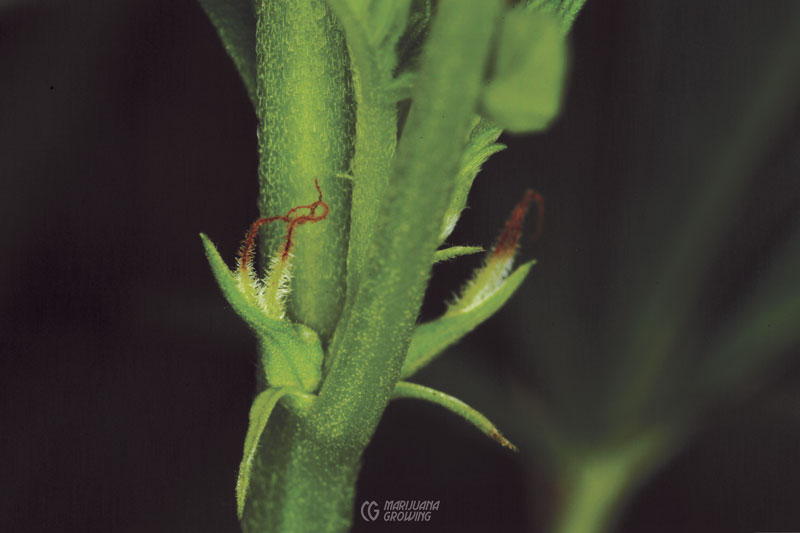
This pre-flower is fully mature, and the stigmas have died halfway.
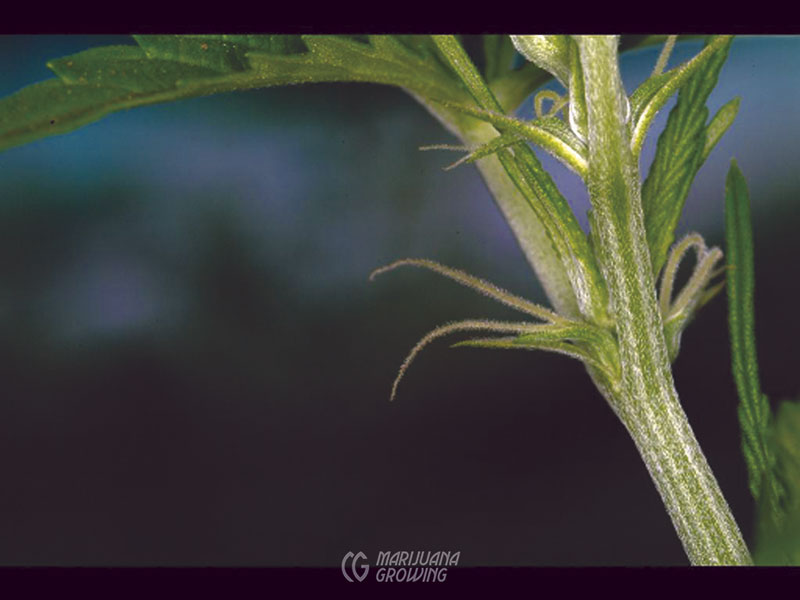
Pre-flower stigmas on this newly designated female are strong and healthy!
Males continue flowering and shedding yellowish, dustlike pollen from bell-shaped pollen sacks well into the females’ flowering stage, which ensures pollination. If you are making seeds, pollinating females too early, before females have developed many receptive female stigmas, will result in a small seed crop.
Males are usually taller than females and have stout stems, sporadic branching, and fewer leaves. In nature, wind and gravity carry pollen from male plants to fertilize (pollinate) receptive females. Male plants produce fewer flowers than females, because one male plant can pollinate many females. Males also contain lower levels of cannabinoids.
Males plants fertilize (pollinate) females, causing females plants to level off THC production and start seed formation. Remove and destroy males, except those that have been selected and used for breeding, as soon as their sex has been determined. The instant they show sex, separate male plants used for breeding from females. Do not let them shed pollen. Unnoticed pollen sacks often form and open early or are hidden under foliage. If growing from seed, take special care to ferret out male flowers and plants. See chapter 9, Harvest, Drying & Curing, for information on removing males from the garden.
See chapter 25, Breeding, for complete information and detailed images of male flowers.

Be on the lookout for small male flowers that may suddenly appear on female plants. Such seemingly harmless male flowers carry viable pollen that will pollinate receptive females.

Tiny stigmas are just starting to emerge from this newly formed female pre-flower.
Female Pre-flowering
After several weeks of normal vegetative growth, plants grown from seed develop pre-flowers. This is when female flower formation initiates, and it is not contingent upon photoperiod. It occurs when a plant is old enough to show signs of sexual maturity, about the fourth week of vegetative growth, or 6 to 8 weeks from seed germination. The pre-flowers emerge behind the stipule about the fourth or fifth branch internodes.
A pre-flower looks like a regular female flower; most have a pair of white fuzzy stigmas. Stigmas normally form after the light-green seed bract of the pre-flower has formed. Wait until stigmas have fully formed to ensure that the plant is a female and not a male. The pre-flowering stage lasts from 1 to 2 weeks.
Plants grown from seed under an 18/6- hour day/night photoperiod will usually show pronounced pre-flowers before plants given a 24/0-hour day/night photoperiod. And under a 16/8-hour day/night regimen, pre-flowers show more quickly and are often more pronounced. As soon as you can distinguish pre-flowers as male or female, males can be culled and females can be induced to flower with a 12/12-hour day/night photoperiod in enclosed gardens.
Wait to induce flowering until pre-flowers have appeared. Inducing flowering with 12 hours of uninterrupted darkness and 12 hours of light before pre-flowers set will cause plant to suffer stress. Such stress could cause strange growth, even cause sex reversal. Inducing flowering before pre-flowers develop does not make plants flower faster; plants will flower at about the same time as if you had waited for pre-flowers to develop.
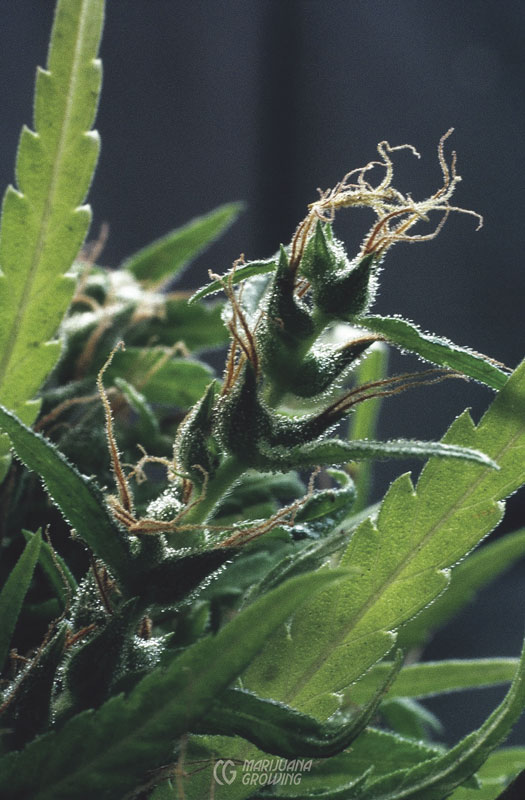
Distinct seed bracts with attached stigmas are easy to distinguish on this 1979 landrace variety from Thailand. (MF)

Flower buds are just starting to develop on this outdoor sativa-dominant plant. Notice that the distance between internodes decreases as stigmas appear and buds develop.

Tiny developing buds with stigmas cover this indoor crop in the Netherlands.
Female Flowering
Female cannabis is prized for heavy cannabinoid production and weighty flower yield. Ideal female, indica-dominant, indoor varieties grow squat and bushy with branches close together on the stem and dense foliage on branches. Outdoor and greenhouse varieties have a similar growth habit with a larger profile. Indoors most varieties show the first female flowers 1 to 3 weeks after inducing flowering with the 12-hour photoperiod. Outdoors, pre-flowers appear a few weeks after planting, and flowering is induced with an 11- to 13-hour day/night photoperiod.
High-quality marijuana consists entirely of female flower clusters; dis- tinct clusters of female marijuana flowers are called buds. Female flowers are about 0.1 to 0.2 inches (2.5–5.1 mm) long and usually form in pairs. But you will see such pairing only in “running” buds most commonly seen in Southeast Asian varieties or on plants stretching for light.
More typically, flowers grow tightly together, forming egg-shaped or teardrop-shaped clusters usually between 0.8 and 3 inches (2–7.6 cm) long; each cluster generally consists of between 30 and 150 densely packed flowers.
Clusters of flower buds (colas) develop rapidly for the first 4 or 5 weeks, after which they grow at a slower rate. Buds put on much of their harvest weight as they swell during the last 2 or 3 weeks of growth before harvest. Pure sativas originating in the tropics can flower for 4 months or longer! Once the ovule has been fertilized by male pollen, seed bract formation and resin production slow, and seed growth starts.

Outdoors in Northern California this sativa-indica cross has plenty of space and sunlight to grow to its fullest potential. Indoors, plants grow much smaller regardless of genetic background.
White, fuzzy female stigmas are fertile as soon as they appear. Unfertilized, these flower buds will continue to develop as sinsemilla. Make sure to keep all male plants and male pollen away from female flowering plants. If female flowers are fertilized by male pollen, seeds will develop and other flower bud growth will slow or stop.
C. indica, C. sativa, and C. ruderalis all have different flowering habits. See “Sinsemilla Flowering” below for more information.
See chapter 25, Breeding, for complete information and detailed images of female cannabis flowers and “Seed- Crop Flowering”; see chapter 17, Light, Lamps & Electricity, for more information on photoperiod and flowering.
Sinsemilla Flowering
Sinsemilla (pronounced sin-semiya) is derived from two Spanish words: sin, which means without, and semilla, which means seed. Sinsemilla is the word that describes flowering female cannabis tops that have not been fertilized by male pollen.
Highly prized medicinal sinsemilla flower buds are the most potent part of any variety, with a proportionately large volume of cannabinoids per flower bud. Unpollinated female plants continue to flower until bract formation and cannabinoid-rich resin production peak, 6 to 10 weeks after turning the lights to 12 hours indoors, inducing flowering in a light deprivation greenhouse or naturally flowering outdoors. During 6 to 10 weeks of flowering, seed bracts develop and swell along the stem, yielding more and heavier flower buds than pollinated, seeded flowers.
Cannabis ruderalis flowers when it is chronologically ready, after about 3 weeks of growth. Many growers report best results with a 20-hour light and 4-hour dark period. Most European seed companies have developed autoflowering-feminized crosses of cannabis ruderalis × indica × sativa. Productive varieties produce 3 to 4 ounces (85–113.4 gm) of dried cannabis flower buds with each 70- to 80-day crop from seed.

This Nigerian landrace flower bud has a wispy growth habit but is still boasts lots of cannabinoid-rich resin. (MF)

Sativa flower buds like this South Indian bud grown in 1981 are much lighter and form more slowly than indicas. (MF)

This beautiful ‘Purple Pineberry’ male plant is heavy with flowers that are just starting to release pollen.
Make any female cannabis plant sinsemilla by removing male plants as soon as they are identified. Removing males virtually guarantees that male pollen will not fertilize succulent female stigmas. Be aware, however, that pollen dispersed from wild or cultivated male cannabis plants could also be floating in the air. Or sometimes a few early grains of pollen are shed by premature male plants that have not been culled. And sometimes an intersex plant with a few male flowers will sprout on a predominately female plant. Read about intersexuality in chapter 25, Breeding.

Indica-dominant ‘Shooting Star’ from Hammerhead Genetics shows a completely different growth habit when cultivated outdoors.
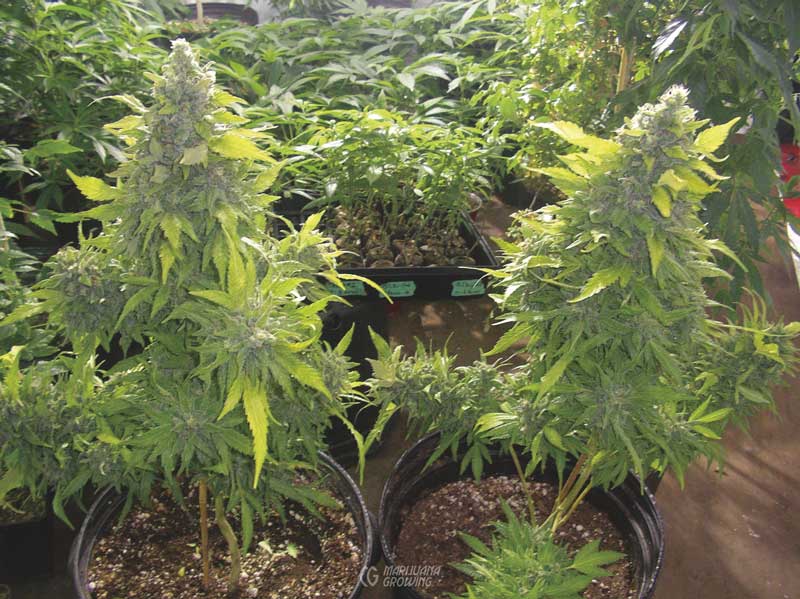
This crop of ‘Bonkers’ with a very strong indica influence grows well indoors and in greenhouses.

‘Matanuska Tundra’ is predominately indica and developed in the Matanuska-Susitna (Mat-su) Valley in Alaska, in conjunction with Sagarmatha Seeds.

‘Grapefruit’ from DNA Genetics is a high-yielding sativa with a sweet taste.

‘NYC Diesel’ is a sativa-dominant variety from Soma Seeds.
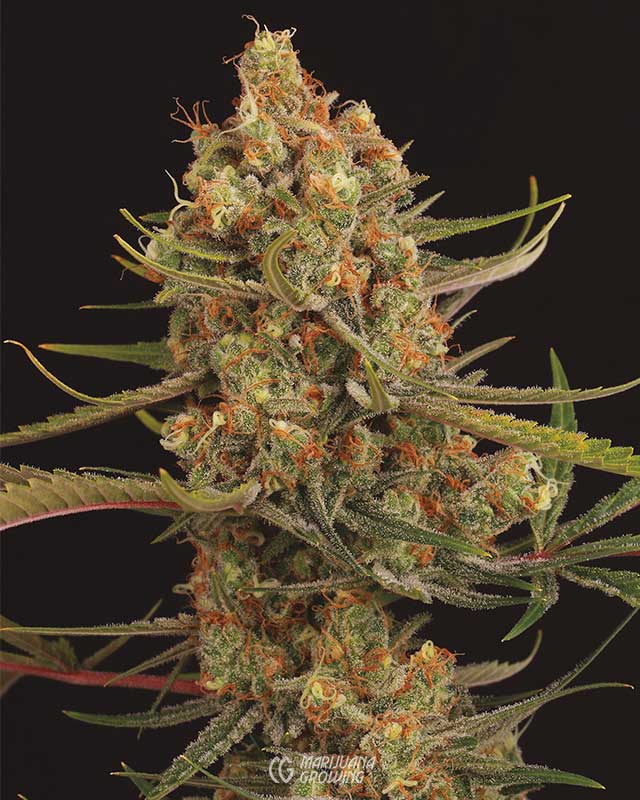
‘Chocolope’ from DNA Genetics is 95 percent sativa with ‘OG Chocolate Thai’ × ‘Cannaloupe Haze’ pedigree.

Daylight-neutral ‘Lowryder’ was crossed with regular ‘Chronic’ to yield this autoflowering variety.

This super-auto (super-autoflowering) variety, ‘Super Stinky’, was developed by Stitch, a French breeder. Such varieties flower after 30+ days, grow to 5 feet (1.5 m), and perform well outdoors.

Purple colors in buds tend to show toward the end of harvest. This bud has a few weeks to go before harvest, as evidenced by the vibrant white stigmas.
Calyx, False Calyx, and Bract
Those general terms—bud, nug, cola, and foxtail—are widely accepted and consistent, but botanical terms are often confused in popular culture. Foremost is the incorrect use of the term calyx. Growers read or hear about swollen calyxes being a sign of maturity and an indication of readiness for harvesting. What are incorrectly called calyxes or false calyxes are correctly identified as bracts.
Bracts might seem a foreign term, but everyone has seen bracts. On poinsettias, the ubiquitous potted plant sold around Christmas, those large red “petals” are actually bracts. On bougainvilleas, the many-colored vines seen everywhere in warmer climates, bracts make up the colorful “petals” that surround a tiny, white inner flower. Cannabis bracts have the densest covering of large, stalked resin glands of any plant part. Bracts make up most of substance and weight of high-quality marijuana buds.

This beautiful cluster of female flowers, here from the variety ‘Blackberry’, is called a nug. A nug most often refers to a dried, dense, often small bud about the size of a thumb’s end joint. Fresh flower clusters are almost always called buds; dried clusters are also commonly called buds. Botanically, marijuana buds are racemes. (MF)
Colas and Foxtails
Cola, a commonly used term for female flower clusters, more often refers to an aggregate of buds that, having formed so closely together, looks like a single, very large bud. Colas form at the ends of stems and branches. Outdoors, meter-long colas can form along the main stem of large plants. Foxtail, another term for cola, is rarely heard these days except from those whose history with cannabis goes back to the 1960s or 1970s. At that time, foxtail most often referred to high-quality individual colas from Mexico in contrast to bagged or compressed bricks of low-quality Mexican colas.

The terms cola or foxtail describe a branch of flower buds that originated in Mexico. Mel Frank snapped this photo of Mexican foxtails in 1976. (MF)
Rejuvenation
Rejuvenate harvested females by leaving several undeveloped lower branches with foliage on plants. Give re-vegetating females an 18/6 day/night photoperiod. Or keep the lights on 24 hours. Keep the temperature above 70ºF (21.1ºC) and below 80ºF (26.7ºC) both day and night. Cool temperatures now will slow reversion to vegetative growth. After several weeks harvested females will stop flowering and “rejuvenate”—revert to the vegetative growth stage.
Leach out old fertilizer in each container and give the harvested leafy, buddy stem stubs a dose of high-nitrogen fertilizer to promote leafy growth. The plants will show signs of reverting to vegetative growth in 4 to 6 weeks. New, green, leafy growth will sprout from branches and flower tops. Leaves will continue to grow more and more “fingers” as re-vegetation progresses.
Let the rejuvenated cannabis plants grow until they are the desired size before taking clones or inducing flowering with a 12-hour photoperiod. If second crops are allowed to grow too tall and lanky, they produce sparse buds. Rejuvenated plants can also be placed outdoors in the spring. Indoors, rejuvenated plants should be induced to flower once they have enough strong foliage.
Rejuvenating harvested cannabis plants is most often used to save the genetics of a particular variety. Rejuvenating plants is never absolute and the results are, for the most part, not pretty. Furthermore, old harvested plants have more problems with diseases and pests. Few cannabis gardeners rejuvenate plants because doing so makes inefficient use of their time and space. A completely new, healthy crop could be grown in the time it takes to rejuvenate plants.

Store seeds in airtight containers along with a packet of silicon crystals to absorb moisture. Make sure to remove, dry, and replace the silicon regularly. (MF)

